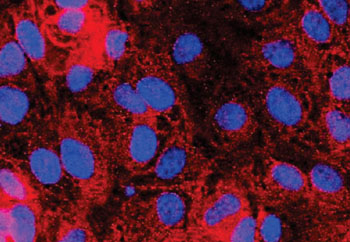First Animal-Free Screening Platforms to Predict Toxic Kidney Injury
By LabMedica International staff writers
Posted on 19 Oct 2015
In a biotechnological advancement involving human induced pluripotent stem cells (h-iPSCs), researchers have developed the first animal-free screening platforms capable of predicting a compound’s toxicity on the human kidney. The new platforms may provide a reliable and efficient tool in evaluating safety of novel compounds and ingredients, as is required in chemical and pharmaceutical as well as food and consumer care industries.Posted on 19 Oct 2015
A team led by Dr. Daniele Zink, principal research scientist at the Institute of Bioengineering and Nanotechnology (IBN; Singapore) of Singapore’s Agency for Science, Technology, and Research (A*STAR), has developed cell-based renal screening platforms that can accurately predict nephrotoxicity. Previous platforms were based on human primary renal proximal tubular cells or similar cells derived from human embryonic stem cells (hESCs). However, primary cells directly harvested from the human body are associated with various problems, including limited availability, while use of hESCs may give rise to ethical and legal concerns. Therefore, the researchers worked on an approach using h-iPSCs, which could also be used to develop patient- and disease-specific models to provide better understanding of renal disease and facilitate development of personalized therapies and drugs.

Image: Renal proximal tubule-like cells (nucleus: blue, cytoplasm: red) derived from induced pluripotent stem cells that have been left untreated (top) or treated with aristolochic acid (bottom), an herbal nephrotoxic compound widely used in traditional Chinese medicine and other herbal remedies, which is now banned in many countries. (Photo courtesy of Singapore’s Institute of Bioengineering and Nanotechnology).
To realize this breakthrough, the scientists invented an effective way of producing human renal cells from h-iPSCs and combined this with machine learning methods that improved the automated and accurate prediction of nephrotoxicity. In addition, this novel platform correctly identified injury mechanisms, which can help advance understanding of the tested compounds.
“Our new kidney screening platforms will be very useful for many industries,” said Prof. Jackie Y. Ying, IBN Executive Director. Due to their role in the elimination of drugs and other foreign compounds, the kidneys are a main target for compound-induced toxicity. Approximately 20% of hospital and community acquired cases of acute kidney injury were caused by such compounds. A drug’s toxic effect on the kidney would typically be discovered in late stages of drug development or even after the product has been marketed. Therefore, the ability to determine toxicity earlier in the development phase would be of great interest.
Among the many challenges associated with using animal models to predict the nephrotoxicity of a new compound are the long time required, high costs involved, unreliable results due to inter-species differences, as well as ethical issues. Therefore, researchers have focused their efforts on developing cell-based screening methods. Animal-free screening methods are now also mandatory for cosmetic companies selling products in the EU, India, and Israel after implementation of animal testing bans in these countries. Validated and accepted animal-free methods for predicting nephrotoxicity are currently not commercially available.
Dr. Zink said, “We have developed the fastest and most efficient protocol for generating kidney cells from induced pluripotent stem cells. Within 8 days, it yielded highly pure kidney cells that were suitable for compound screening. We also worked closely with Dr. Lit-Hsin Loo’s team from the Bioinformatics Institute, which developed the data analysis procedures and machine learning methods that allow us to predict drug-induced nephrotoxicity with great accuracy. We were further able to identify injury mechanisms and drug-induced cellular pathways by using automated cellular imaging. We hope that our work will contribute to the development of safer products.” The team plans to work with partners to further validate and apply the platforms.
The study, by Kandasamy K et al. was published July 2015 in the journal Scientific Reports.
Related Links:
Institute of Bioengineering and Nanotechnology














